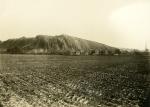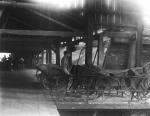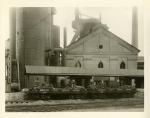![header=[Marker Text] body=[Founded 1794 as Reading Furnace by ironmaster George Ege. In 1845 Henry P. Robeson expanded the furnace, spurring establishment in 1855 of the town of Robesonia. Although the furnace itself ceased operation and was razed in 1927, the Georgian-style ironmaster's mansion, Italianate office building, workers' houses, and other structures survived. The district is located one mile south of here.] sign](http://explorepahistory.com/kora/files/1/10/1-A-2AB-139-ExplorePAHistory-a0k1t3-a_450.jpg)
Mouse over for marker text
Name:
Robesonia Furnace
Region:
Hershey/Gettysburg/Dutch Country Region
County:
Berks
Marker Location:
U.S. 422 (Penn Ave.) at Freeman St., Robesonia
Behind the Marker
Two ironmasters, George Ege and Henry Robeson, created two very different chapters in Robesonia Furnace's history. In 1794 Ege built a charcoal furnace, which became the heart of his iron plantation.
Robeson transformed iron production when he acquired the operation in 1845, razing the charcoal furnace and constructing an anthracite-coal furnace. In 1854 he went one step further, replacing his first anthracite furnace with a second much larger one. Robesonia represented a major, mid-century shift from charcoal-fueled to anthracite furnaces.
Ege took iron ore from Cornwall Banks, twenty-five miles away, and wood from area forests to make charcoal. In 1807 he built a Georgian mansion and several workers' houses, part of the iron plantation that he developed. Ege died in 1829, leaving the plantation in the hands of a trustee. When the trustee sold the plantation in 1836, it included the charcoal furnace, mansion, a gristmill, sawmill, numerous other buildings, 6,000 to 7,000 acres of land, and the right to mine iron ore from Cornwall Banks.
Cornwall Banks, twenty-five miles away, and wood from area forests to make charcoal. In 1807 he built a Georgian mansion and several workers' houses, part of the iron plantation that he developed. Ege died in 1829, leaving the plantation in the hands of a trustee. When the trustee sold the plantation in 1836, it included the charcoal furnace, mansion, a gristmill, sawmill, numerous other buildings, 6,000 to 7,000 acres of land, and the right to mine iron ore from Cornwall Banks.
Robeson acquired the plantation in 1845 and quickly implemented major changes. He replaced the Reading Furnace with a hot blast anthracite furnace capable of making fifty tons of iron a week, much more than the earlier charcoal furnace. In 1854 he and his partners constructed an anthracite furnace with a capacity of 240 tons a week. In 1855 Robeson also developed a plan for a new town with the anthracite furnace at its heart. This plan, revised in 1859 and bearing the name Robesonia, was the basis for the town's subsequent development.
Robeson joined many other eastern Pennsylvania ironmasters in moving from charcoal to anthracite furnaces. By mid-century, ironmasters were attracted increasingly to the advantages of anthracite furnaces. Frederick Overman noted in an 1854 treatise on iron manufacturing the need for "mineral fuel as a substitute for wood in the manufacture of iron." He also noted another very important reason ironmasters such as Robeson adopted anthracite coal as a fuel. Demand for iron was growing, particularly from the burgeoning railroad industry.
Iron manufacturers wanted to keep pace with growing demand for rails, but they could not increase the size of charcoal furnaces to increase output. Charcoal was easily crushed under the weight of too much iron ore and limestone, limiting the size of the stack. Crushed charcoal blocked the flow of the air blast, smothering combustion and smelting. On the other hand, anthracite coal could bear far more weight, and ironmasters greatly increased the size and output of anthracite furnaces. By 1849 anthracite furnaces had an average capacity of 4,000 tons per year, three times that of charcoal furnaces.
As Overman had noted, by 1850 wood was becoming increasingly scarce near charcoal furnaces in Pennsylvania. Wood cutters, such as those at Centre Furnace, leveled forests near charcoal furnaces, so they often had to go farther afield for wood, driving up the cost of charcoal fuel. By comparison, anthracite appeared to be in limitless supply in eastern Pennsylvania. And anthracite also enabled ironmasters to cut the cost of fuel by approximately half and thus lower their production costs and increase profits at anthracite furnaces. Ironmasters in eastern Pennsylvania had strong economic incentives to switch to anthracite fuel.
Centre Furnace, leveled forests near charcoal furnaces, so they often had to go farther afield for wood, driving up the cost of charcoal fuel. By comparison, anthracite appeared to be in limitless supply in eastern Pennsylvania. And anthracite also enabled ironmasters to cut the cost of fuel by approximately half and thus lower their production costs and increase profits at anthracite furnaces. Ironmasters in eastern Pennsylvania had strong economic incentives to switch to anthracite fuel.
Technological advances also enabled ironmasters to turn to anthracite fuel. In particular, development of the hot blast was critical to using anthracite fuel, which ignited and burned only at a high temperature. The hot blast re-circulated hot gases otherwise blown out the top of the stack, redirecting them into the furnace, pre-heating the blast, and raising the combustion temperature.
 David Thomas and others adopted hot blast technology from Britain and applied it to anthracite-coal furnaces during the 1830s and 1840s. Ironmasters also adapted it to charcoal furnaces, increasing the output of hot-blast charcoal furnaces in 1849. Still, anthracite furnaces with hot-blast technology were clearly superior to charcoal furnaces in terms of cost, output, and profits. In 1849 fifty-seven anthracite furnaces in eastern Pennsylvania produced forty-three percent of the state's total iron output, compared to 230 charcoal furnaces making almost all the rest of the iron produced in the state.
David Thomas and others adopted hot blast technology from Britain and applied it to anthracite-coal furnaces during the 1830s and 1840s. Ironmasters also adapted it to charcoal furnaces, increasing the output of hot-blast charcoal furnaces in 1849. Still, anthracite furnaces with hot-blast technology were clearly superior to charcoal furnaces in terms of cost, output, and profits. In 1849 fifty-seven anthracite furnaces in eastern Pennsylvania produced forty-three percent of the state's total iron output, compared to 230 charcoal furnaces making almost all the rest of the iron produced in the state.
Robesonia's anthracite furnaces proved productive and successful. Ironically, however, one source of their success proved to be their undoing. When Robeson purchased Reading Furnace, he acquired Ege's right to take iron ore from Cornwall Banks, the most important source of iron ore in Pennsylvania. By the early 1900s Robesonia Furnace was mining 100,000 tons of ore annually.
When the Bethlehem Steel Corporation bought Cornwall Banks in 1926, it determined to monopolize all the iron ore. In 1927 it bought Robesonia Furnace and demolished its competitor for iron ore. The furnaces are now long gone, but remaining buildings and the name of the town testify to Robeson's influence.
Bethlehem Steel Corporation bought Cornwall Banks in 1926, it determined to monopolize all the iron ore. In 1927 it bought Robesonia Furnace and demolished its competitor for iron ore. The furnaces are now long gone, but remaining buildings and the name of the town testify to Robeson's influence.
Robeson transformed iron production when he acquired the operation in 1845, razing the charcoal furnace and constructing an anthracite-coal furnace. In 1854 he went one step further, replacing his first anthracite furnace with a second much larger one. Robesonia represented a major, mid-century shift from charcoal-fueled to anthracite furnaces.
Ege took iron ore from
Robeson acquired the plantation in 1845 and quickly implemented major changes. He replaced the Reading Furnace with a hot blast anthracite furnace capable of making fifty tons of iron a week, much more than the earlier charcoal furnace. In 1854 he and his partners constructed an anthracite furnace with a capacity of 240 tons a week. In 1855 Robeson also developed a plan for a new town with the anthracite furnace at its heart. This plan, revised in 1859 and bearing the name Robesonia, was the basis for the town's subsequent development.
Robeson joined many other eastern Pennsylvania ironmasters in moving from charcoal to anthracite furnaces. By mid-century, ironmasters were attracted increasingly to the advantages of anthracite furnaces. Frederick Overman noted in an 1854 treatise on iron manufacturing the need for "mineral fuel as a substitute for wood in the manufacture of iron." He also noted another very important reason ironmasters such as Robeson adopted anthracite coal as a fuel. Demand for iron was growing, particularly from the burgeoning railroad industry.
Iron manufacturers wanted to keep pace with growing demand for rails, but they could not increase the size of charcoal furnaces to increase output. Charcoal was easily crushed under the weight of too much iron ore and limestone, limiting the size of the stack. Crushed charcoal blocked the flow of the air blast, smothering combustion and smelting. On the other hand, anthracite coal could bear far more weight, and ironmasters greatly increased the size and output of anthracite furnaces. By 1849 anthracite furnaces had an average capacity of 4,000 tons per year, three times that of charcoal furnaces.
As Overman had noted, by 1850 wood was becoming increasingly scarce near charcoal furnaces in Pennsylvania. Wood cutters, such as those at
Technological advances also enabled ironmasters to turn to anthracite fuel. In particular, development of the hot blast was critical to using anthracite fuel, which ignited and burned only at a high temperature. The hot blast re-circulated hot gases otherwise blown out the top of the stack, redirecting them into the furnace, pre-heating the blast, and raising the combustion temperature.
Robesonia's anthracite furnaces proved productive and successful. Ironically, however, one source of their success proved to be their undoing. When Robeson purchased Reading Furnace, he acquired Ege's right to take iron ore from Cornwall Banks, the most important source of iron ore in Pennsylvania. By the early 1900s Robesonia Furnace was mining 100,000 tons of ore annually.
When the
Beyond the Marker










